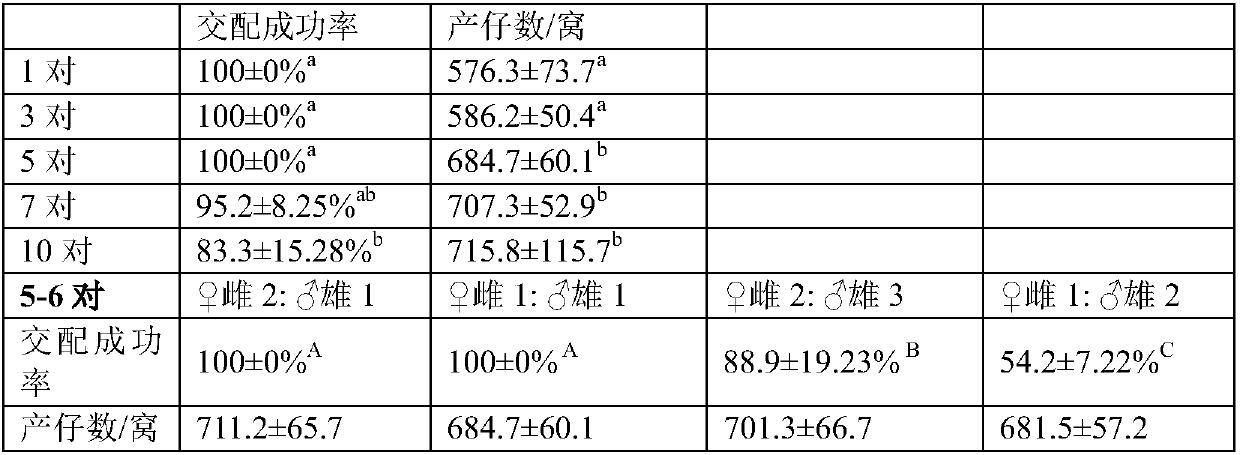A kind of overwintering and artificial propagation method of sea dragon
A technology of artificial breeding and sea dragon, applied in application, climate change adaptation, fish farming, etc., to achieve high growth rate, wide adaptable temperature range, and high larvae output rate
- Summary
- Abstract
- Description
- Claims
- Application Information
AI Technical Summary
Problems solved by technology
Method used
Image
Examples
specific Embodiment
[0019] A method for overwintering and artificial propagation of sea dragons, comprising the following steps:
[0020] (1) Overwintering culture Place wild-caught sea dragons that have been domesticated artificially in fiberglass tanks, and control the breeding conditions as follows: temperature 8-20°C; salinity 18-32; light intensity 30-120Lx; oxygenation 5-10L / h, the breeding water level is 60-100 centimeters, and the breeding density is 80-100 tails / square; the seawater for cultivation is sea crystal plus aerated tap water to prepare a solution with a salinity of 25-28 or natural seawater through sand filtration; the bait is Frozen brine shrimp or frozen mysis larvae, the bait size is 0.5-1 cm, feeding twice a day, the feeding time is 8 am and 2 pm, the feeding amount is 12-15% of the wet weight of the hippocampus, every evening Replace 15-25% of seawater after removing residual bait and feces by sucking dirt before turning off the lights;
[0021] (2) Parent body nutritio...
Embodiment 1
[0030] The bottom area of parent sea dragon nutritional enhancement is 0.5m 2 , In a glass fiber reinforced plastic barrel with a volume of 300L, the intensified test of Hailong's body is carried out. Set the sea dragon density to 10, 15, 20, 25, 30 pairs / barrel, and the water temperature gradient to 16, 18, 20, 22°C. Investigate the feeding rate and growth rate of sea dragons in each treatment. Feed live brine shrimp (cultured for 1 week after hatching), live mysis larvae (body length 0.5-1 cm) or larvae (body length 0.7-0.8 cm) of some prawns (such as Penaeus vannamei, Penaeus chinensis, etc.), The feeding density is 50-80 sea dragons per tail, and the feeding can be divided into two times a day. Every evening before turning off the lights, suck dirt to remove residual bait and feces, and then change 10-15% isothermal seawater. The test lasted for 2 weeks, and the results are shown in Table 1 and Table 2. As the temperature rises, the growth rate of sea dragon is increa...
Embodiment 2
[0038] The sex ratio and density of the broodstock are in the same size fiberglass barrel as in Experiment 1 to test the optimal sex ratio and the best stocking density of the sea dragon broodstock. A total of two experiments were designed, one of which set 5 sea dragon density gradients, respectively 1, 3, 5, 7, 10 pairs / barrel (female to male ratio 1:1), the water temperature was 20±1°C; the other experiment selected The parent density of 5-6 pairs / barrel, set 4 sex ratio gradients, respectively 2:1, 1:1, 2:3, 2:1, and the breeding temperature is 20±1℃. Investigate the mating of sea dragons in each treatment Success rate and average number of sea dragon larvae per litter. Other test conditions are the same as the above example, and the results are shown in Table 3. The density of different broodstock has an impact on their mating and pregnancy. From the perspective of the mating success rate, the greater the density of the breeding broodstock in the environment, the mating ...
PUM
 Login to View More
Login to View More Abstract
Description
Claims
Application Information
 Login to View More
Login to View More - R&D
- Intellectual Property
- Life Sciences
- Materials
- Tech Scout
- Unparalleled Data Quality
- Higher Quality Content
- 60% Fewer Hallucinations
Browse by: Latest US Patents, China's latest patents, Technical Efficacy Thesaurus, Application Domain, Technology Topic, Popular Technical Reports.
© 2025 PatSnap. All rights reserved.Legal|Privacy policy|Modern Slavery Act Transparency Statement|Sitemap|About US| Contact US: help@patsnap.com



